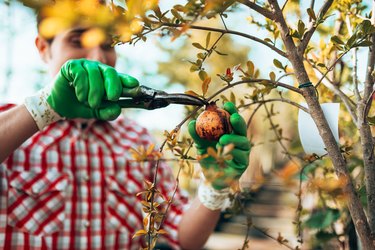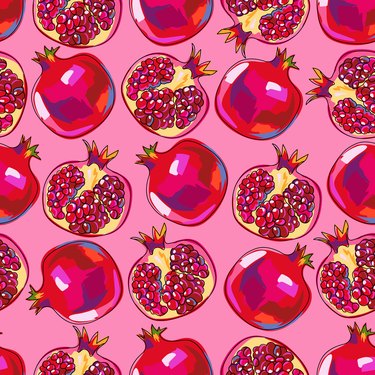
Pomegranates (Punica granatum) are the quintessential Mediterranean fruit, and both the blossoms and fruit are strikingly beautiful in the garden. Unfortunately, most of us don't live in a Mediterranean climate, which is why hardy cultivars like the Utah pomegranate are so enticing. "Hardy" is a relative term—the Utah Sweet grows best in USDA plant hardiness zones 8 to 10—but if you have a sunny indoor spot for them in winter, you could conceivably enjoy a productive pomegranate tree in most parts of the United States. Here's how to care for one indoors or outdoors.
Where to Grow Pomegranates
Video of the Day
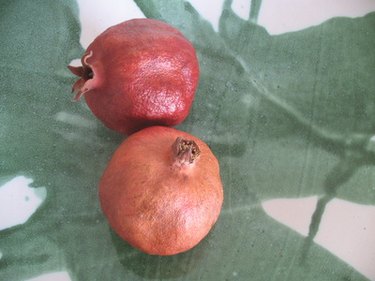
Pomegranates are native to, or naturalized from, the Mediterranean region through Iran to northern India. The areas where pomegranates flourish have a few things in common: They're sunny, warm and arid. That's why California is home to the bulk of commercial pomegranate production in the U.S., and pomegranates are most readily grown by home gardeners in places like Arizona or New Mexico. That being said, if you live in a colder or damper climate, you can still grow a cold-hardy varietal, like Utah Sweet, if you're prepared to do a bit of extra work.
Video of the Day
In a damper climate, you can provide improved drainage for your pomegranate tree with high-drainage soil and through physical methods, such as planting in an elevated spot or installing French drains near the tree to carry away excess rain. In cooler climates, you'll need to take advantage of the most favorable microclimate you can find on your property and usually provide some form of shelter over the winter. In areas where hard freezes can be expected, it's best to treat your pomegranate as a patio plant that's wheeled outside in summer and brought indoors over winter. In any location, they'll need full sun in order for their fruit to ripen properly, but they can tolerate some shade if your interest in them is primarily ornamental.
While some nurseries describe the Utah Sweet and other hardy pomegranates as viable in zone 6, that's probably unrealistic. They're happiest in zones 8 to 10 and could conceivably flourish in 7a with a favorable microclimate. Otherwise, you'll need to winter them indoors or grow them in a greenhouse or solarium.
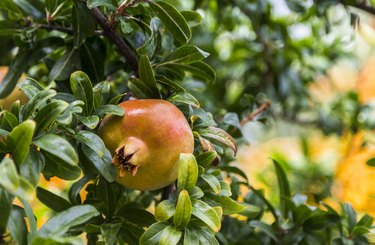
How to Grow a Utah Sweet
Order the largest, best-established tree you can afford from a reputable nursery. It takes about three years for a pomegranate to produce, so buying a second-year or third-year tree saves time (and pruning).
When it comes to planting, choose a spot with good drainage, full sun and some shelter from the wind. Then, dig a hole larger than the root ball and fill it with well-rotted manure, mature compost or other organic material. Plant the tree so that the top of its root ball remains level with the surface and water it in well.
Until you see new growth, it will need watering every couple of weeks if the weather doesn't obligingly provide rain. Once the tree begins to establish itself, it's drought-tolerant, though young trees need more irrigation than mature trees with well-established root systems.
Commercial growers use a spacing of up to 16 feet between pomegranate trees, but in a home setting (where maximum production isn't as crucial), you can have them closer if you wish. For an unusual hedge, for example, you could plant them 6 feet apart and allow sucker growth to fill in the intervening spaces.
Tip
If your Utah Sweet will be a patio plant or indoor plant, start it in a planter that’s at least 14 inches deep and 14 to 16 inches (or more) in diameter. That’s enough soil to keep it happy and healthy for several years. Over time, as it becomes root bound, you’ll want to move it to a larger pot. Once you’ve reached the largest pot you can comfortably manage, the planter’s size becomes the constraint that keeps it a suitably small tree. You can do some root pruning to keep it healthier in any size of planter.
Utah Sweet Pomegranate Tree Care
You can treat your pomegranate tree as either a bush or a tree. If you want it to look like a standard fruit tree, remove all but the sturdiest single stem and stake it to help it grow straight and strong. Remove all sucker growth from the bottom foot of the plant and then in the second and third years, select sturdy side branches to provide its structure. (If you buy a third-year tree, it is likely that the nursery will have already done this.)
To grow it as a bush, select five or six well-spaced stems and then remove the rest along with any sucker growth. Train your chosen stems into a vase shape so light and air can circulate through the bush.
Tip
Plants that are shaped bush-fashion are more cold-tolerant than single-stem trees.
Pomegranate fruits set on new growth, so before the growing season begins (while the plants are still dormant), you can periodically cut back the outer 1/4 of each branch's length, choosing a spot just past a pair of buds. Those will create new stems and give your pomegranate plant an increasingly bushy (and fruitful) growth habit. They'll seldom set fruit in the colder growing zones unless you're in a greenhouse or have an unusually hot summer, but you'll still get to enjoy the beautiful, colorful blossoms.

Poms don't need a lot of ongoing care other than pruning. Once they're established, pruning is usually limited to removing dead or damaged branches. During the first few years, it's helpful to mulch with additional manure or compost and to fertilize two to three times per year with a balanced, good-quality fertilizer (8-8-8 or 10-10-10). Up to 1 pound of fertilizer is appropriate for young pomegranates, while productive mature plants can take up to 3 pounds. Don't go overboard, as overfertilization leads to foliage growth at the expense of blossoms and fruit, and it can cause fruit to drop prematurely.
Tip
Pomegranates aren’t susceptible to a lot of pests. Most of those that do occur are attracted by split or decaying fruit. Splitting occurs when there’s too much rain as the fruits near maturity. So, slow down on watering and if necessary, use tarps or plastic covers around your pomegranate to minimize the amount of rain that soaks into the immediate vicinity. This slows their uptake of water and protects the fruits. Remove split, damaged or overripe fruits immediately to deter bugs.
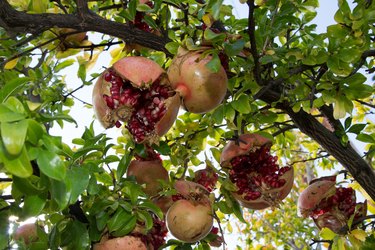
Picking Fruits From a Utah Sweet
If you live in a suitable climate or provide your tree with a hot and sunny indoor/outdoor environment, you can expect to get fruits. Utah Sweets are self-pollinating, so you can get fruits from just one tree, though fruit set is heavier if you have a second tree for cross-pollination. A well-grown tree can produce up to 50 pounds of fruit in your garden.
The apple-size pomegranates will ripen to a delicate shade of pink as opposed to the vivid red fruits you see at the supermarket. (Those are usually the Wonderful cultivar.) The arils (the edible fleshy part around the pomegranate seeds) are pink as well, and the seeds aren't as hard and crunchy as those from Wonderful pomegranate trees. If you object to the crunch, that's a positive. Utah Sweet, as the name suggests, is sweeter and less tart than other pomegranates. So, it won't bring quite the same tart punch or vivid color to your smoothies or desserts, but the fruits are still full of antioxidants and vitamin C.
The fruits are ready to harvest once they're full-size, have ripened to pink and can be easily twisted from the stem. To avoid damaging the tree, cut the fruits away when you carry out your main harvest. A ripe pomegranate will have a satisfyingly dense, almost metallic sound when tapped. They'll keep in the refrigerator for months if you have space; otherwise, you can juice or dry the arils for more space-efficient storage.
